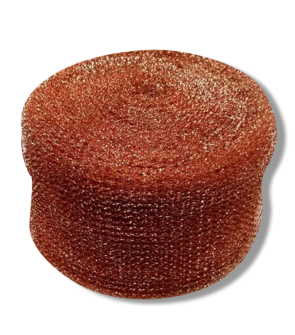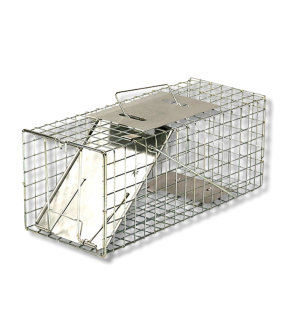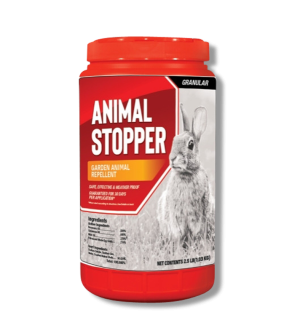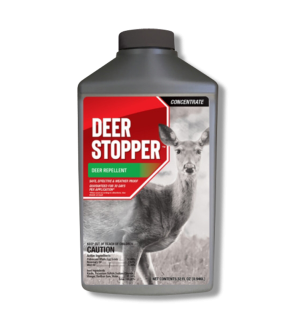Wildlife Prevention Tips
Most Effective Products
Wildlife Prevention Tips
This page is a general DIY guide that will help you control or prevent various wildlife from visiting your yard through our recommended products and tips. When following the directions on the product labels, local and state laws are still present and must be followed. It is recommended for homeowners to visit with their local animal control office or state website to visit proper rules and regulations associated with the control of listed wildlife.
Wildlife interactions such as squirrels, racoons, rabbits, opossum, deer, and skunks are becoming more common with the rise of human populations and developments of homes.
These animal populations are plentiful within our neighborhoods or homes and they peacefully coexist with homeowners. However, due to weather changes, decrease of territory, or food shortage these animal populations will invade your homes property. When these wildlife populations do invade, they can cause minor to major problems such as health or structural issues within homes for homeowners.
This page will discuss common wildlife infestations within your yard and the different ways you can help to avoid these animals through our professional products and tips. Using these following products and methods will address existing wildlife issues and prevent future reinfestations.
Squirrels

Squirrels are small rodents that range in size from small to medium, but will generally have slender bodies with long bushy tails and large eyes. While most homeowners are not in immediate danger in the prescence of squirrels they can still pose a series of issues.
Typically damage from these pest will be from gnawing on electrical wiring, insulation, siding of home, trees, and vegetation. During cooler months or loss of habitat, squirrels will often move into attics, eaves, soffits, and walls.
If you are unsure of an interior infestation listen for thumping sounds during the day or examine for any open voids or holes on the siding of your home or roof. A squirrels diet will consist of nuts, seeds, and fruit which are often found in trees, bird feeders, or gardens on your property.
Racoons

Raccoons are a common pest throughout the United States that can inhibit urban, agricultural, and forestry environments. They can easily be identified by the black mask over their eyes, and a heavily furred, ringed tail. Raccoons also possess sharp nonretractable claws that help them to climb various trees, structures, and sides of homes.
Some homeowners are led to believe that racoons will only inhibit areas close to water due to the belief they posses no salivary glands and must moisten their food to eat. However, raccoons posses well-developed salivary glands and will often be a predatory instinct to search for aquatic pray in the water. As adapt climbers, they will spend a duration of the day in wooded areas such as fallen trees, upright trees, barns, sheds, garages, attics, basements, or voids within crawl spaces.
Besides structural damage within electrical wiring and ventilation, raccoons also pose the threat of carrying various diseases such as rabies. Transmission of diseases can also be encountered through indirect contact such as urine or feces. Raccoon waste is similar to that of a dog and can be found in areas where they are frequently inhibiting.
Rabbits

Despite their innocent appearance, rabbits have a reputation of being invasive turf, ornamental, and garden pests within residential and urban properties.
Depending on the species of rabbit their color will range between reddish brown, grey, black, or white. As a herbivore, rabbits will feed on various type of foliage and vegetation. They are commonly found in bushes, field edges, crops, near flowerbeds or crops, woody plants, around or underneath trees, and landscaped properties that provide plenty of cover.
As a year long pest, rabbits will leave signs of their activity by gnawing on tree bark, leaves of plants or turf, and small circular pellets of feces.
Opossum

Opossums are small to medium sized mammals that grow up to 2 feet long and weight between 6 to 15 pounds. Their fur color is silver with a hint of white hues, but predominately white on the opossums elongated face. Other recognizable features are their long hairless tails, pink noses, black five-toed paws, black ears, and white whiskers.
Like racoons, opossums urine and feces poses multiple health issues and displeasing odors. The most common sign of infestation other than waste is knocked-over trashcans, deceased poultry such as small chickens or geese, and evidence of gnawing on plants.
When confronted, opossums will often play dead until you or the imposing threat such as your pets have left the area. Once out of sight, opossums will retreat and climb up trees, fence posts, or other structures within your property. However, they do have the tendency to hiss or part their mouth to bare their teeth to scare you or the danger away.
Deer

Deer is one of the largest species of pest within this article that can be identified at a distance with their elongated legs, split black hooves, large slender heads, and white fur that reaches across their stomachs to the underside of their tails.
Deer are commonly active during the early morning to late evening, and will scatter once they witness you or your pets. However, if there is a open and available food source then deer will likely return to the area to continue feeding.
Unlike rabbits, deer will tear at the edges of ornamental leaves and turf leaving jagged edges. As shy and docile creatures, deer will graze along the edges of your property, bushlines, crop fields, and sometimes in the middle of grassy areas if they suspect no immediate danger. If not witnessed, you can look for signs of tracks from their cloved hoofs or small to medium sized oval-shaped pellets that range from black to brown in color.
Skunks

Skunks are nuisance pests that cause considerable damage to crops, small poultry livestock, and significant damage to turf while foraging for soil-borne insects. As omnivores, they will eliminate poultry that is smaller than them and eat their eggs.
The easiest tell-tale sign of a skunk infestation is to smell a strong, sulfuric odor within your property. Otherwise, you will see signs of their activity when turf, gardens, and ornamental plants have been uprooted. Skunks are black and white stripped mammals that will defend themselves against predators by emitting a high chemical odor from their rear.
Skunks are found throughout the United States and are common in woodland, residential, and agricultural areas. They will primarily be active at night and hide underneath porches, sheds, homes, or piles of wood.
How to Control Wildlife Within Your Property
When you have confirmed the listed wildlife activity, you can then proceed with the following tips and methods.
When dealing with pests that depend on their sense of smell it is best to utilize protective personal equipment (PPE) such as gloves or masks. By wearing the appropriate personal protective equipment such as gloves, masks, safety glasses, long-sleeve shirts, long-sleeve pants, coveralls, and closed-toe shoes with socks helps to increase your products success and personal safety.
Step 1: Mow Property as Needed

Controlling the height of vegetation and foliage within your lawn can help to deter herbivore pests or ones that depend on insects within the soil.
Mowing your lawn when it reaches a height of 3 inches or more helps to strengthen its roots and decrease the presence of wildlife populations. Continually mowing your yard is one of the best habitat control for wildlife populations.
Additionally, this will also help to remove damaged turf that has been gnawed on by rabbits or deer.
Step 2: Remove Outdoor Food Sources

After removing excess plant growth from your property, you will want to take away food sources for your omnivorous pests such as opossums or raccoons. Both of these pests can feast on pet food, small poultry, eggs, and contents within your trash can. You will want to remove as many competing food sources to increase the likelihood of pests visiting your traps.
To do this, you will want to secure the lid of your outdoor garbage bins, remove any unfinished pet food, secure entries to chicken or poultry coops, and ensure that all poultry have returned to their homes.
For other food sources such as gardens or ornamental foliage use chicken coop wiring to wrap around the perimeter of the area. This will help to keep pests from feasting on the foliage or digging for insects in these areas. Remember, with deer infestations they can jump as high as eight feet so you will want to use wiring as high as 9 feet.
Step 3: Seal Crack and Crevices with Caulk and Copper Mesh

Seal all crack and crevices or voids within the siding of your home, roof, and foundation to prevent pests from revisiting these areas.
Many of these repairs are necessary for pests such as squirrels, opossums, or raccoons since they are more likely to invade the interior of your home. Each one of these pests will gnaw or dig their way through your insulation and roof to create homes for themselves or search for food.
Repair these areas with copper-wire mesh, which will deter gnawing from squirrels and cover with caulk to prevent larger pests from re-entering. You will need to replace all torn or broken window and ventilation covers.
Step 4: Bait and Set the Trap in Shade
Once all competing food sources have been removed and homes and gardens are secured you can then proceed with following step. Depending on the pest, a small or large Solutions Humane Live Trap would be best. Make sure to wear gloves before baiting and setting the trap to help mask your scent.
It is best to place the trap in the patterns of the pests walkways and in an area that has access to shade or not in direct sunlight as trapped animals can perish within a few hours if left in the sunlight for too long.
To set the Solutions Humane Live Trap, you will have to push on the door lock and lift the door plate then pulling the trigger arm forward until the trigger arm hook catches the door. You will want to use a highly aromic bait based on the animals diet such as sardines for skunks or peanut butter wrapped with seeds for squirrels.
When placing bait inside your trap it is important to position it at the back of the trap to lure pests inside. Continually monitor the traps and contact local animal control to remove the pest from your property or appropriate releasing instructions.
Unfortunately, it is illegal in most states to capture or contain a deer. For deer infestations, you will want to use a repellent product such as scram or wire fencing around available food sources.
Step 5: Treat Yard with Appropriate Repellent
Once the pest has been removed from your property you will want to prevent future reinfestations with naturally repellents. Depending on the imposing wildlife infestation, you will select one of the scram products.
Messinas products are non-toxic repellents that you can use around your property, flower beds, and homes to naturally drive away wildlife. You will want to inspect areas with activity and apply the appropriate scram product. Each Messinas repellent product is specified for a specific species of pest and will be less effective against non-listed wildlife.
You may apply your granule repellent by hand while wearing gloves or with a handheld spreader. If liquid, then you may need to use a handheld pump sprayer.
Carefully shake the granule product out of the container and pour into the top of the spreader. If liquid then pour in the appropriate amount of water and product then shake until solution is mixed.
Stand near the edge of the target area and apply in appropriate bands as listed on the product label's directions.
To control deer with Deer Stopper Repellent Concentrate then spray the top and bottom of desired leaves until wet. When using near edible crops, apply a perimeter application.
To control skunks and rabbits with Animal Stopper Granular Repellent, apply the product liberally to animal dens, tunnels, other entry points used by the pest, and around garden plants and flower beds. It may also be used on dormant fruit and nut trees.
Key Takeaways
What Species of Wildlife will Visit Your Yard?
- Deer, squirrels, raccoons, rabbits, opossums, or skunks are species of wildlife that invade residential lawns and neighborhoods.
Why is Wildlife Visiting Your Property?
- Various types of wildlife will visit your lawn due to decrease of habitat, food, and water. If your property provides substantial vegetation such as gardens or crops, poultry, and cover then pests will invade.
How to Prevent Wildlife From Visiting Your Yard?
- Protect your property by removing as many potential sources of food. For organic plant matter, secure it by wrapping chicken coop wiring around its perimeter or applying repellent products like Messinas. For persistent pests, you will need to use baits and small to large sized humane traps.
















































































































































































































































































































































































































































































































































